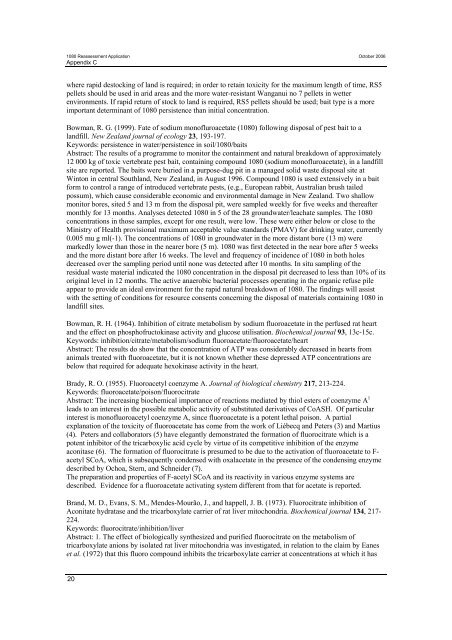Source: Landcare Research (1964). Control of poisons. Royal ...
Source: Landcare Research (1964). Control of poisons. Royal ...
Source: Landcare Research (1964). Control of poisons. Royal ...
You also want an ePaper? Increase the reach of your titles
YUMPU automatically turns print PDFs into web optimized ePapers that Google loves.
1080 Reassessment Application October 2006<br />
Appendix C<br />
where rapid destocking <strong>of</strong> land is required; in order to retain toxicity for the maximum length <strong>of</strong> time, RS5<br />
pellets should be used in arid areas and the more water-resistant Wanganui no 7 pellets in wetter<br />
environments. If rapid return <strong>of</strong> stock to land is required, RS5 pellets should be used; bait type is a more<br />
important determinant <strong>of</strong> 1080 persistence than initial concentration.<br />
Bowman, R. G. (1999). Fate <strong>of</strong> sodium mon<strong>of</strong>luroacetate (1080) following disposal <strong>of</strong> pest bait to a<br />
landfill. New Zealand journal <strong>of</strong> ecology 23, 193-197.<br />
Keywords: persistence in water/persistence in soil/1080/baits<br />
Abstract: The results <strong>of</strong> a programme to monitor the containment and natural breakdown <strong>of</strong> approximately<br />
12 000 kg <strong>of</strong> toxic vertebrate pest bait, containing compound 1080 (sodium mon<strong>of</strong>luroacetate), in a landfill<br />
site are reported. The baits were buried in a purpose-dug pit in a managed solid waste disposal site at<br />
Winton in central Southland, New Zealand, in August 1996. Compound 1080 is used extensively in a bait<br />
form to control a range <strong>of</strong> introduced vertebrate pests, (e.g., European rabbit, Australian brush tailed<br />
possum), which cause considerable economic and environmental damage in New Zealand. Two shallow<br />
monitor bores, sited 5 and 13 m from the disposal pit, were sampled weekly for five weeks and thereafter<br />
monthly for 13 months. Analyses detected 1080 in 5 <strong>of</strong> the 28 groundwater/leachate samples. The 1080<br />
concentrations in those samples, except for one result, were low. These were either below or close to the<br />
Ministry <strong>of</strong> Health provisional maximum acceptable value standards (PMAV) for drinking water, currently<br />
0.005 mu g ml(-1). The concentrations <strong>of</strong> 1080 in groundwater in the more distant bore (13 m) were<br />
markedly lower than those in the nearer bore (5 m). 1080 was first detected in the near bore after 5 weeks<br />
and the more distant bore after 16 weeks. The level and frequency <strong>of</strong> incidence <strong>of</strong> 1080 in both holes<br />
decreased over the sampling period until none was detected after 10 months. In situ sampling <strong>of</strong> the<br />
residual waste material indicated the 1080 concentration in the disposal pit decreased to less than 10% <strong>of</strong> its<br />
original level in 12 months. The active anaerobic bacterial processes operating in the organic refuse pile<br />
appear to provide an ideal environment for the rapid natural breakdown <strong>of</strong> 1080. The findings will assist<br />
with the setting <strong>of</strong> conditions for resource consents concerning the disposal <strong>of</strong> materials containing 1080 in<br />
landfill sites.<br />
Bowman, R. H. (<strong>1964</strong>). Inhibition <strong>of</strong> citrate metabolism by sodium fluoroacetate in the perfused rat heart<br />
and the effect on phosph<strong>of</strong>ructokinase activity and glucose utilisation. Biochemical journal 93, 13c-15c.<br />
Keywords: inhibition/citrate/metabolism/sodium fluoroacetate/fluoroacetate/heart<br />
Abstract: The results do show that the concentration <strong>of</strong> ATP was considerably decreased in hearts from<br />
animals treated with fluoroacetate, but it is not known whether these depressed ATP concentrations are<br />
below that required for adequate hexokinase activity in the heart.<br />
Brady, R. O. (1955). Fluoroacetyl coenzyme A. Journal <strong>of</strong> biological chemistry 217, 213-224.<br />
Keywords: fluoroacetate/poison/fluorocitrate<br />
Abstract: The increasing biochemical importance <strong>of</strong> reactions mediated by thiol esters <strong>of</strong> coenzyme A 1<br />
leads to an interest in the possible metabolic activity <strong>of</strong> substituted derivatives <strong>of</strong> CoASH. Of particular<br />
interest is mon<strong>of</strong>luoroacetyl coenzyme A, since fluoroacetate is a potent lethal poison. A partial<br />
explanation <strong>of</strong> the toxicity <strong>of</strong> fluoroacetate has come from the work <strong>of</strong> Liébecq and Peters (3) and Martius<br />
(4). Peters and collaborators (5) have elegantly demonstrated the formation <strong>of</strong> fluorocitrate which is a<br />
potent inhibitor <strong>of</strong> the tricarboxylic acid cycle by virtue <strong>of</strong> its competitive inhibition <strong>of</strong> the enzyme<br />
aconitase (6). The formation <strong>of</strong> fluorocitrate is presumed to be due to the activation <strong>of</strong> fluoroacetate to Facetyl<br />
SCoA, which is subsequently condensed with oxalacetate in the presence <strong>of</strong> the condensing enzyme<br />
described by Ochoa, Stern, and Schneider (7).<br />
The preparation and properties <strong>of</strong> F-acetyl SCoA and its reactivity in various enzyme systems are<br />
described. Evidence for a fluoroacetate activating system different from that for acetate is reported.<br />
Brand, M. D., Evans, S. M., Mendes-Mourão, J., and happell, J. B. (1973). Fluorocitrate inhibition <strong>of</strong><br />
Aconitate hydratase and the tricarboxylate carrier <strong>of</strong> rat liver mitochondria. Biochemical journal 134, 217-<br />
224.<br />
Keywords: fluorocitrate/inhibition/liver<br />
Abstract: 1. The effect <strong>of</strong> biologically synthesized and purified fluorocitrate on the metabolism <strong>of</strong><br />
tricarboxylate anions by isolated rat liver mitochondria was investigated, in relation to the claim by Eanes<br />
et al. (1972) that this fluoro compound inhibits the tricarboxylate carrier at concentrations at which it has<br />
20








![Application for test certificate [pdf, 131kb]](https://img.yumpu.com/50666502/1/184x260/application-for-test-certificate-pdf-131kb.jpg?quality=85)








